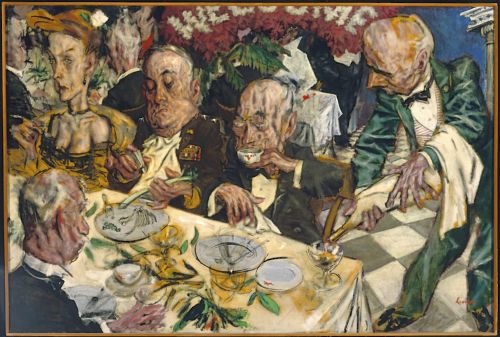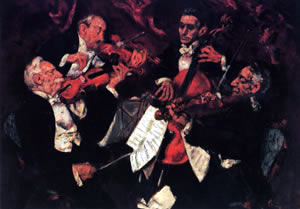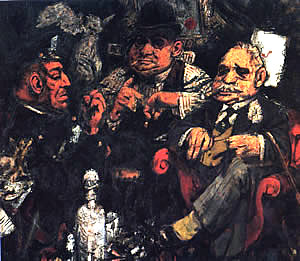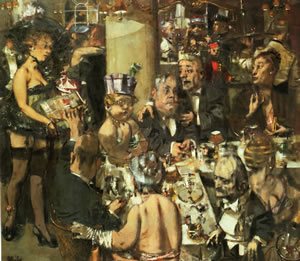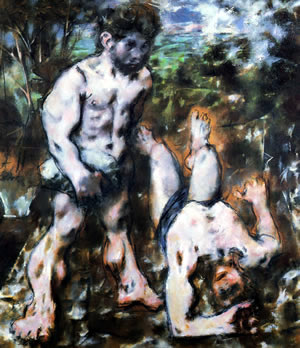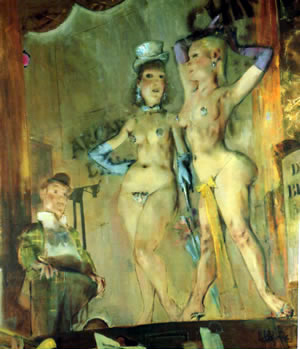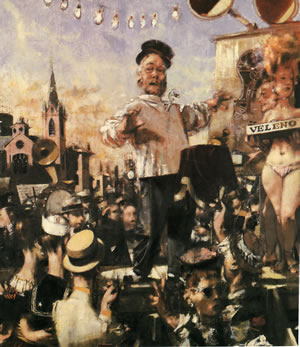
| THE HANDSTAND | NOVEMBER-DECEMBER2010 |
Social Realist artist Jack Levine diesLevine's son-in-law, Leonard Fisher, said the artist died on Monday, November 9, AP reported.
Born to Lithuanian Jewish parents in 1915, Levine first achieved wide recognition for his 1937painting The Feast of Pure Reason, a critique of political corruption, which was purchased by the Museum of Modern Art.
Levine's early works were influenced by artists such as Bloom, Chaim Soutine, Georges Rouault and Oskar Kokoschka. He was then associated with the style known as Boston Expressionism.
Levine served in the army from 1942 to 1945 and painted Welcome Home upon being discharge from service. The painting which was a lampoon of the arrogance of military power caused political controversy when it was displayed in a Moscow exhibition years later.
Best known for his satires on modern life, political corruption as well as the distorted and exaggerated forms of his figures, Levine fell out of fashion with the emergence of mid-century abstract art.
"I love the Old Masters," he said in 2005. "I don't care for anybody modern. ... I want to paint with the dead ones."
Levine is also famous for his Biblical paintings and his Cain and Abel was acquired by the Vatican in 1973.
"I am primarily concerned with the condition of man," he said in 1952. "The satirical direction I have chosen is an indication of my disappointment in man, which is the opposite of saying that I have high expectations for the human race."
Levine's works are housed in numerous major museums across the world including the Art Institute of Chicago, New York's Museum of Modern Art and Metropolitan Museum of Art, and the National Gallery of Art in Washington.
TE/HGH/MMN www.PressTV.com
I went with some young art students into the Copley Society, which was a kind of a sketch club. It was a life class and this nice looking woman came out and took off her kimono. And stood there nude. I nearly fainted. My mind went blank. The hell with drawing. I wanted to look at that!
–Jack’s first life class; he was 22.
In John Updike’s novel, Seek My Face, the artist Jackson Pollock character is said to have despised the social realist Jack Levine because he had so many Old Master tricks up his sleeve (which Pollock didn’t). Levine and his friend Hyman Bloom were Boston boys who were virtually adopted by Denman Ross at Harvard and given a classical art education in the 1930s.
An artist whom Levine alienated himself from was Jackson Pollock, who referred to him and Ben Shahn as “illustrators...when you try to emulate the old masters...you get corn, real corn. Bits of Renaissance pastiche.”
–Rodman, Conversations with Artists.
The Feast of Pure Reason caught a capitalist, a policeman, and a politician in convivial discussion. The painting was done under the auspices of the WPA, which donated it to the Museum of Modern Art. But the trustees of the museum debated at length before allowing the painting to be exhibited, fearful of offending the capitalists who had endowed the museum.
–Marcia Corbino, American Artist, 1985.
Cain and Abel
Not many American artists have been told by Pope Paul VI that their work will always be welcome in the Vatican Museums. But that’s what the Pope said two years ago to Jack Levine, at the time his Cain and Abel was purchased for the Vatican.
– The New York Times, 1975.
The fact that Picasso can draw like no other artist since Leonardo, that is his saving grace and the thing he will be remembered for. Not the fact that he invented Cubism and other gadgets.–Jack Levine, in Rodman’s Conversations with Artists.
I don’t think there’s such a thing for me as pure painting, if pure painting is all it’s about. It’s not enough. Otherwise we’d have housewives all over Long Island, dripping paint on the kitchen floors. To make an avant garde kitchen floor.
Jack Levine–2005
Essentially a city dweller, I find that the aspects of man and his environment in a large city are all I need to work with. I find my approach to painting inseparable from my approach to the world. Justice is more important than good looks. The artist must sit in judgment and intellectually evaluate the case of any aspect of the world he deals with. The validity of his work will rest on the humanity of his decision. A painting is good for the very same reason that anything in this world is good.
–Jack Levine.
I consider a college degree in the arts a certificate of incompetence.”
–Jack Levine, 1985.
